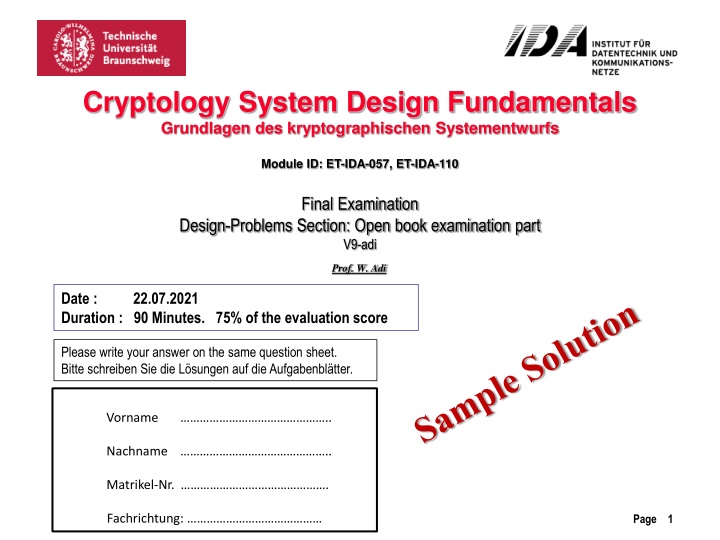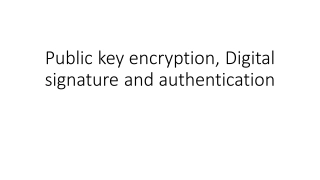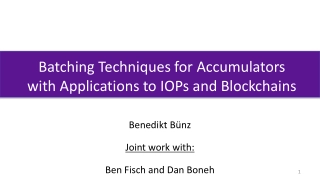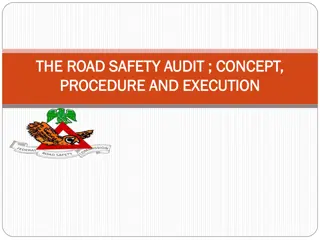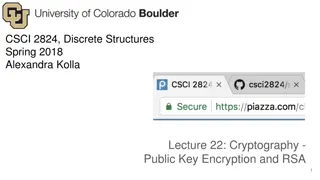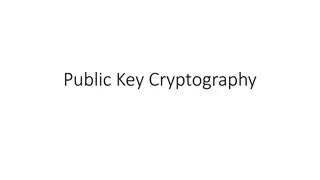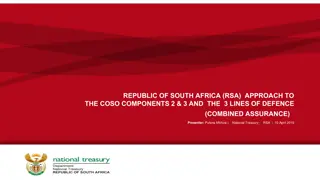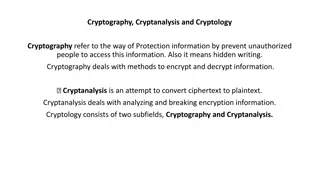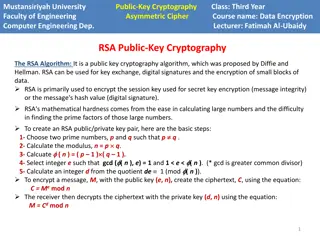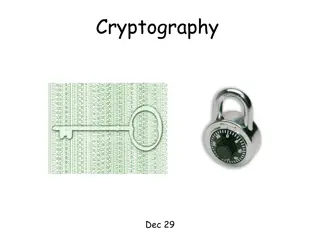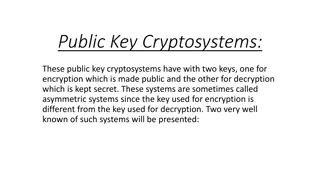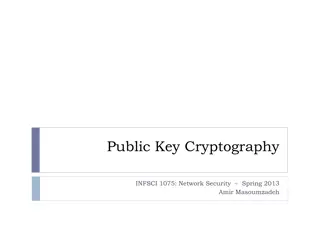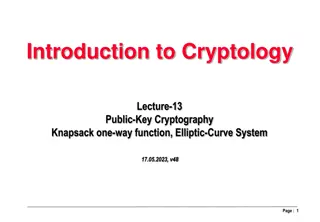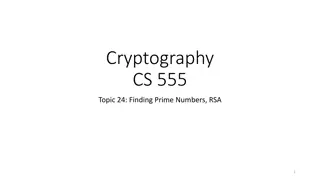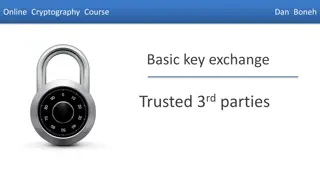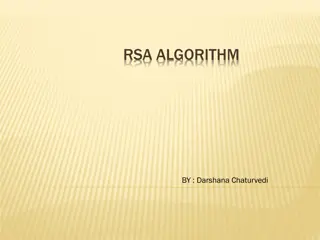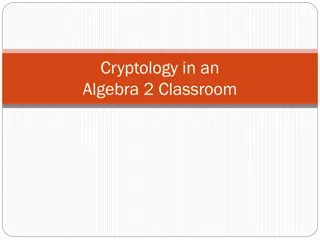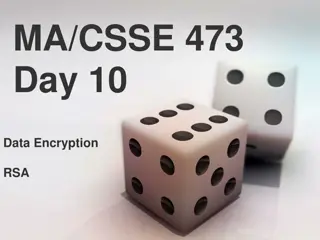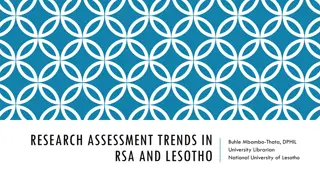Cryptology System Design Fundamentals - RSA Public Key System Analysis
The RSA public key system analysis involves determining suitable public and secret keys for users A and B, calculating distinct possible public keys, decrypting cryptograms, generating digital signatures, and discussing data ranges for secure communication. The solution covers the key generation process and addresses security concerns related to encryption and decryption procedures.
Download Presentation

Please find below an Image/Link to download the presentation.
The content on the website is provided AS IS for your information and personal use only. It may not be sold, licensed, or shared on other websites without obtaining consent from the author.If you encounter any issues during the download, it is possible that the publisher has removed the file from their server.
You are allowed to download the files provided on this website for personal or commercial use, subject to the condition that they are used lawfully. All files are the property of their respective owners.
The content on the website is provided AS IS for your information and personal use only. It may not be sold, licensed, or shared on other websites without obtaining consent from the author.
E N D
Presentation Transcript
Cryptology System Design Fundamentals Grundlagen des kryptographischen Systementwurfs Module ID: ET-IDA-057, ET-IDA-110 Final Examination Design-Problems Section: Open book examination part V9-adi Prof. W. Adi Date : Duration : 90 Minutes. 75% of the evaluation score 22.07.2021 Please write your answer on the same question sheet. Bitte schreiben Sie die L sungen auf die Aufgabenbl tter. Vorname .. Nachname .. Matrikel-Nr. . Page 1 Fachrichtung:
Max 75% of the marks Marks: Problem 1 22 Problem 2 7 Problem 3 26 Problem 4 25 Total 80 Page 2
Problem Problem 1 1: : RSA Public Key System RSA Public Key System (22 P) ARSA cryptosystem with two users A and B having the following secret prime number pairs: for user A: 29 and 13 and for user B: 37 and 7. 1. Find out the adequate public key of user A from the following list of integers: [ 48, 121, 168] giving the reason for your choice. Compute the corresponding secret key of user A. 2. Find out the adequate public key of user B from the following list of integers: [ 36, 49, 108] giving the reason for your choice. Compute the corresponding secret key of user B. 3. How many distinct public keys are possible for each user? 4. User A received the cryptogram YB= 97 from user B. Decipher the cryptogram YBon user A s side to get the original data M. 5. (a) User A computes the digest H(M) =M2 mod NA. A then signs the resulting digest H to generate his signature SA. (b) Compute SA. 6. Verify A s signature SAon side B. 7. Which range of data values for M would operate adequately for enciphering M for communication between user A and others. Why? 8. (a) Why is it generally not possible for an adversary to reveal M from H(M)? (b) For which range of M can an attacker reveal the Message M by observing YB and SA? State the necessary computations to reveal M. Page 3
Solution Problem 1: Solution Problem 1: 1. What is the adequate public key of user A from the following list of integers: [ 48, 121, 168], why? NA = 29 x 13 = 377 (NA ) = (29-1)(13-1-1) = 28 x 12 = 336 Since: gcd [ EA, (NA ) ] = 1 Select, EA = 121 3 Compute the corresponding secret key of user A: GCD m 336 121 94 27 13 u a1 1 0 1 -1 4 a2 0 1 -1 4 -9 b1 0 1 -2 3 -11 b2 1 -2 3 -11 25 q 2 1 3 2 13 r INVERSE VALUE = B2 121 94 27 13 1 94 27 13 1 0 2 DA = 121-1 mod 336 = 25 FALSE INVERSE= 25 GCD= 1 2. What is the adequate public key of user B from the following list of integers: [ 36, 49, 108], why? NB = 37 x 7= 259 (NB) = (37-1)(7-1) = 36 x 6 = 216 gcd (EB, (NB ) ] = 1 Select, EB = 49 3 Compute the corresponding secret key of user B. GCD m 216 49 20 9 2 u 49 20 9 2 1 a1 1 0 1 -2 5 a2 0 1 -2 5 -22 b1 0 1 -4 9 -22 b2 1 -4 9 -22 97 q 4 2 2 4 2 r INVERSE VALUE = B2 20 9 2 1 0 2 DB = 49-1 mod 216= 97 FALSE INVERSE= 97 GCD= 1 Page 4
Solution Problem 1: Solution Problem 1: 3. How many distinct public keys are possible for each user? 2 # of keys for user A = [ (NA )] = (336) = 24 x 3 x 7 x (1-1/2) (1-1/3) (1-1/7)= 96 keys, 336=24 x 3 x 7 # of keys for user B = [ (NB )] = (216) = 23 x 33 x (1-1/2) (1-1/3)=72 keys, 216=23 x 33 4. User A received the cryptogram YB= 79 from user B. Decipher the cryptogram YBon user A s side to get the original data M. ? = (??)?? ??? ?? ? = (97)25 ??? 377 = 201 2 5. (a) User A computes the digest H(M) = M2 mod NA. 2 ? = ?2 ??? ??= 2012 ??? 377 = 62 (b) User A signs the resulting digest h to generate his signature SA. ??= (?(?))?? ??? ?? ??= (62)25 ??? 377 = 179 2 6. Verify A s signature SAon the side of B: B computes the digest: H = (??)?? ??? ??= 179121 ??? 377 = 62 Comparsion 2 H = ?2 ??? ??= 2012 ??? 377 = 62 Verification : Page 5
2 Cont. Solution Problem 1: Cont. Solution Problem 1: 7. Which range of data values for M would operate adequately for enciphering M for communication between user A and others. Why? Range from 0 to NA-1 = 377-1 = 376. These are the only elements which can be represented in Z377 8. (a) Why is it generally not possible for an adversary to reveal M from H(M)? (b) For which range of M can an attacker reveal the Message M by observing YBand SA? State the necessary computations to reveal M. (a) As H(M) = M2mod Na, Computing M= M2mod Nais not possible as the factorization of Nais not feasible according to the state of the art (Rabin Lock: square root computation in a ring is equivalent to factorization)... (b) If M < NA , in that case, the hash value H(M)= M2mod NA= M2( As M2< NA). The adversary can get H ? = (??)????? ??= ?2, Computing the square root of M2in this case is possible (without modulus). That is: M2= M , We have only two answers M = M The correct M =M is the one which fulfils ??= (? )????? ?? or M = NA M Example: for M=15 < 377 , ??= (?)????? ??= = (15)121??? 377 = ??? ??= (?(?))????? ??= ??= (225)25??? 377 = ??? Adversary Computes: ?2= H = (??)????? ??= ???121??? 377 = 225 M = 225 = 15, M = 15 or M = 377-15= 362 Check: choice M = 15, yields (?)????? ??= (15)121??? 377 = 171= ??. => Correct choice or M = 362 => (362)121??? 377 = 206 ?? ( which do not match the sent YB) => Not correct!
in GF(26 6) ) Arithmetic Arithmetic in GF(2 Solution Problem 2: Solution Problem 2: (7 P) 1. 2. Compute the multiplicative inverse of x4+ x3+ x2+ x modulo P(x) = x6+ x5 + x4+x2+1 Verify your result. Solution: Solution: 1. Multiplicative inverse computation B2= B1 q B2 P1(x) P2(x) B1(x) B2(x) Q(x) R(x) x6+ x5 + x4+x2+1 x4+ x3+ x2+ x x3-x2+1 x2 0 1 X4+x3+x2+x x3+x2+1 x x2 x2 1 5 x+1 x3+x2+1 x2 x2 x3+1 1 1 x3+1 x4+x3+x2+x+1 x2 x2 0 2. Result verification (x4+ x3+ x2+ x+1)(x4+ x3+ x2+ x ) = (x4+ x3+ x2+ x)2+x4+ x3+ x2+x 2 P(x) = x6+ x5 + x4+x2+1 x6= x5 + x4+x2+1 x7= x6 + x5+x3+x = x5 + x4+x2+1+ x5+x3+x = x4+x3+x2+x+1 x8= x5 + x4+x3+x2+1 = x8+x6+x4+x2+x4+x3+x2+x =x5+x4+x3+x2+x+x5+x4+x2+1+x+x3 = 1 x4+ x3+ x2+ x+1 x3+ x2+1 x4 +x3+ x x2 x3+ x2+1 x2 x3 x2+1 x2+1 x2 x2 1 x x 1 Page 7
EL EL- -Gamal Cryptosystem over GF(2 Gamal Cryptosystem over GF(26 6) ) Problem 3: Problem 3: (26 P) Set up ElGamal public-key system over GF(26) as in (Fig. 1). The used field modulus is an irreducible primitive polynomial P(x). The secret keys for users A and B are 19 and 7 respectively. 1. Which multiplicative orders are possible for elements in GF(26)? Why? 2. (a) Which is a primitive element in GF(26): x5or x9to be used as a public directory element ? Why? (b) Compute the number of primitive elements in GF(26)? 3. Compute the public keys of user A and user B for the selected . 4. (a) Send the message M = 2from user A to B and use the random value R = 31 for this message. (b) Compute C and r. 5. Decrypt the cryptogram C to receive the message M on the side of user B. Page 8
Fig.1 Fig.1 ElGamal ElGamalSecrecy Secrecy- -System (1985) System (1985) User A sends M to B User B receives primitive element in GF(2m) ya= Xapublic key of A yb= Xbpublic key of B Xa= secret key of A Xa Xb= secret key of B Xb C M C = M . Xb . R X X M / m Z-1 = -Xb. R Z = Xb. R yb (yb)R r = R r (r)-Xb = -Xb. R / - Xb R m-bits R - Xb= (2m-1) - Xb Random Generator : R = 0 ... 2m-2 a new R is needed for every message Notice: The scheme applies similarly over GF(2m) with as a primitive element in that field. Page 9
Solution Problem Solution Problem 3 3: : 1. Which multiplicative orders are possible for elements in GF(26)? Why? The possible orders are the divisors of 26 1 = 63 1, 3, 7, 9, 21 and 63 2 2 2. (a) Which one is a primitive element in GF(26): x5or x9 ? Why? P(x) is primitive polynomial x is primitive Ord(x) = 63 which is the highest possible multiplicative order. For ? = ?5: ??? ? = ??? ?5= gcd(??? ? ,5)= For ? = ?9 ??? ? = ??? ?5= gcd(??? ? ,9)= ? = x5is the primitive element 2 ???(?) 63 gcd(63,5)= 63 = highest possible multiplicative order. 2 ???(?) gcd(63,9)=63 63 9= 7 highest possible multiplicative order. 2 (b) Compute the number of primitive elements in GF(26)? The number of primitive elements is the number of the elements that have an order which is equal to the highest possible order which is 63 (63) = (32x7) = 32x7 x (1-1/3) x (1-1/7) = 3x 2 x 6 = 36 2 3. Compute the public keys of user A and user B. 2 User B User A 2 Secret Key: ??= 19 Public Key: ??= ???= (?5)19= ?95 ??? 63= ?32 Secret Key: ??= 7 Public Key: ??= ???= (?5)7= ?35 Page 10
Solution Problem 3: Solution Problem 3: 4. (a) Send the message M = 2from user A to B using the random value R = 31 for this message. 2 ? = ?2= (?5)2= ?10 ? = (??)?= (?35)31= ?1085 ??? 63= ?14 2 (b) Compute C and r. 2 ? = ? ? = ?10 ?14= ?24 ? = ??= (?5)31= ?155 ??? 63= ?29 2 5. Decrypt the cryptogram C to receive the message M on the side of user B. 2 ??= 2? 1 ??= 26 1 7 = 56 ? 1= ? ??= (?29) 7= ? 203 ??? 63= ?49 2 ? = ? ? 1= ?24 ?49= ?73 ??? 63= ?10 2 Page 11
Massey Massey- -Omura Pass Protocol over GF(2 Pass Protocol over GF(25 5) ) Omuralock for Shamir s 3 lock for Shamir s 3- - Problem 4: Problem 4: (25 P) A Massey-Omura lock for Shamir s 3-Pass Protocol over GF(25) using the irreducible polynomial p(x) = x5+ x2+ 1 is used as a field modulus. 1. Compute the multiplicative order of x. 2. Compute the element x20and x40in binary format with minimum number of steps. 3. The secret key for users Aand B are 23 and 13 respectively. A message M = x21is sent from A to B. Compute all the exchanged 3-pass messages as powers of x with the smallest possible power of x. 4. Compute the number of possible distinct secret keys for each user. 5. Compute the maximum number of simple exponentiation search cycles required to break the cipher by a known clear text cipher text attack? (technical reasons are required!) Page 12
Solution Problem 4: Solution Problem 4: A Massey-Omura lock for Shamir s 3-Pass Protocol over GF(25) using the irreducible polynomial p(x) = x5+ x2+ 1 is used as a field modulus 1. Compute the multiplicative order of x . Possible multiplicative orders are the divisors of 25-1 = 32-1=31; Divisors of 31 are: 1, 31 2 x1 1, => multiplicative order of x is 31 2. Compute the elements: x20and x40with minimum number of steps x5= x2+1 x6= x3+x x7= x4+x2 x8= x5+x3= x3+ x2+1 p(x)= x5+ x2+ 1 x5= x2+1 2 x20= (x5)4= (x2+1)4= x8+ 1 = x3+ x2= 01100 2 2 x40= (x20)2= (x3+ x2)2= x6+ x4= x3+x+ x4= 11010 Page 13
Solution Problem 4: Solution Problem 4: 3. The secret key for users A and B are 23 and 13 respectively. A message M = x21 is sent from A to B. Compute all the exchanged 3-pass messages as powers of x with the smallest possible power of x. GCD m 31 23 8 7 u 23 8 7 1 a1 1 0 1 -2 a2 0 1 -2 3 b1 0 1 -1 3 b2 1 -1 3 -4 q 1 2 1 7 r 8 7 1 0 INVERSE VALUE = B2 Keys of the user A Ea= 23 2 INVERSE= -4 GCD= 1 Da= Ea-1 = 23 -1mod 31 = 31-4= 27 2 GCD m 31 13 5 3 2 u 13 5 3 2 1 a1 1 0 1 -2 3 a2 0 1 -2 3 -5 b1 0 1 -2 5 -7 b2 1 -2 5 -7 12 q 2 2 1 1 2 r 5 3 2 1 0 Keys for user B Eb= 13 INVERSE VALUE = B2 INVERSE= 12 GCD= 1 Db= Eb-1 =13 -1mod 31 =12 Page 14
Solution Problem Solution Problem 4 4: : Keys of the user A Ea= 23, Da= 27 Keys for user B Eb= 13, Db= 12 1 Arithmetic in GF(25) User A User B M = x21 x18 1 x18.13 mod 31=x234 mod 31 = x17 (x21)23= x 21.23 mod 31=x483 mod 31 = x18 2 2 2 x17 27 ( ) x17 12 ( ) ( ) x25 = M 3 x25 (x25)12 mod 31= x21=M x17x27 mod 31=x459 mod 31=x25 2 2 4. Compute the number of possible distinct secret keys for each user # of keys for each user is (31) = 31-1 = 30 2 Page 15
5. Compute the maximum number of simple exponentiation search cycles required to break the cipher by a known clear text cipher text attack? (technical reasons are required!) 2 Aknown clear text-cipher text known M and known cryptogram y = MEa The attacker needs to run a program that searches for t = Eawhich happens when Mt=y The order of any M 0 is 31, as 31 is a prime number. Possible Eavalues are 1 to 31. that is the search for Eastarts by M1M2 . Up to M30 Since the # of usable keys for each user is 30 the attacker needs to check a maximum of 30 possible values of Ea 30 is the number of the possible exponenetiation search cycles required. Page 16
